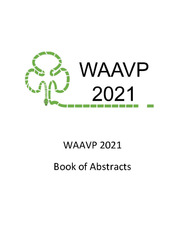Приказ основних података о документу
In Vivo Potential of Thyme (Thymus vulgaris L.) Essential Oil and Synergistic Combination of Linalool:Estragole to Control Sheep Gastrointestinal Nematodes
| dc.creator | Štrbac, Filip | |
| dc.creator | Bosco, Antonio | |
| dc.creator | Amadesi, Alessandra | |
| dc.creator | Rinaldi, Laura | |
| dc.creator | Stojanović, Dragica | |
| dc.creator | Simin, Nataša | |
| dc.creator | Orčić, Dejan | |
| dc.creator | Pušić, Ivan | |
| dc.creator | Krnjajić, Slobodan | |
| dc.creator | Ratajac, Radomir | |
| dc.date.accessioned | 2023-06-05T10:57:35Z | |
| dc.date.available | 2023-06-05T10:57:35Z | |
| dc.date.issued | 2021 | |
| dc.identifier.uri | http://rimsi.imsi.bg.ac.rs/handle/123456789/1972 | |
| dc.description.abstract | Economic losses caused by sheep gastrointestinal nematodes (GIN) are increasing nowadays due to the development of anthelmintic resistance, therefore requiring a search for alternatives. In doing so, field testing of new potential substances provides credible and realistic insight of current possibility of their use. The aim of this study was to evaluate the in vivo anthelmintic potential of thyme, Thymus vulgaris L. essential oil (EO) and synergistic combination of two compounds, linalool:estragole on days 7 and 14 post-treatment using the faecal egg count reduction test (FECRT). The experiment was conducted on two separate farms located in southern Italy, whereby the total number of sheep (n=96, n=48 per farm) was divided into four groups on each farm (n=12). Groups received the following treatments perorally: G1 – 100 mg kg-1 T. vulgaris; G2 – 100 mg kg-1 linalool:estragole; G3 – standard dose of fenbendazole and G4 – 50 ml per animal of sunflower oil. Main compounds of thyme EO identified by gas chromatographymass spectrometry (GC-MS) analyses were p-cymene (41.72%), thymol (31.59%) and α-terpineol (11.71%), and the coproculture examination showed the presence of four genera of sheep GIN on tested farms: Haemonchus, Trichostrongylus, Teladorsagia and Chabertia. In total, results of the FECRT showed the following reductions of GIN eggs on day 7: 24.95% (T. vulgaris); 24.64% (linalool:estragole) and 82.49% (fenbendazole). On day 14, reductions of GIN eggs were: 23.72% (T. vulgaris), 25.91% (linalool:estragole) and 88.82% (fenbendazole). Furthermore, no toxic effects were observed in animals at these doses. The present study reveals the anthelmintic potential of tested substances. However, a new trial with modified conditions is needed to improve their effectiveness: increased dosage, a different way of administration or possible use of encapsulated or nanoencapsulated forms of these substances, especially if bearing in the mind anatomical-physiological specifics of the ruminant gastrointestinal tract. | sr |
| dc.language.iso | en | sr |
| dc.publisher | World Association for the Advancement of Veterinary Parasitology (WAAVP) | sr |
| dc.rights | openAccess | sr |
| dc.source | Book of Abstracts of the 28th International Conference of the World Association for the Advancement of Veterinary Parasitology (WAAVP), Dublin, Ireland | sr |
| dc.subject | gastrointestinal nematodes | sr |
| dc.subject | anthelmintic resistance | sr |
| dc.subject | thymus vulgaris | sr |
| dc.subject | linalool and estragole | sr |
| dc.subject | in vivo test | sr |
| dc.title | In Vivo Potential of Thyme (Thymus vulgaris L.) Essential Oil and Synergistic Combination of Linalool:Estragole to Control Sheep Gastrointestinal Nematodes | sr |
| dc.type | conferenceObject | sr |
| dc.rights.license | ARR | sr |
| dc.citation.epage | 517 | |
| dc.citation.spage | 517 | |
| dc.identifier.fulltext | http://rimsi.imsi.bg.ac.rs/bitstream/id/4959/bitstream_4959.pdf | |
| dc.identifier.rcub | https://hdl.handle.net/21.15107/rcub_rimsi_1972 | |
| dc.type.version | publishedVersion | sr |

